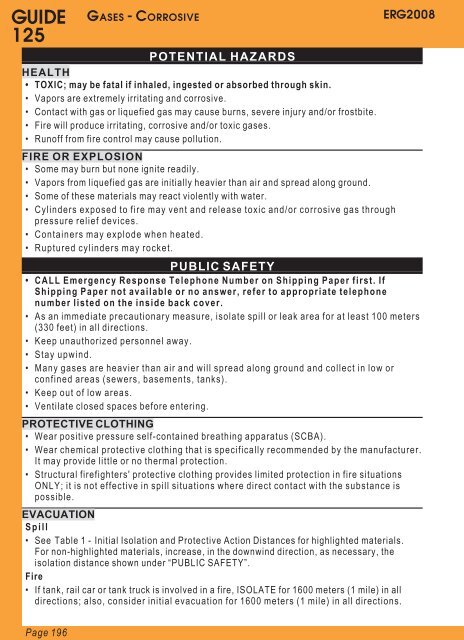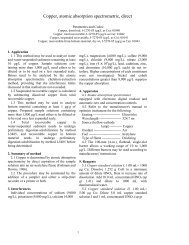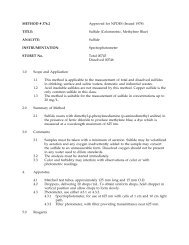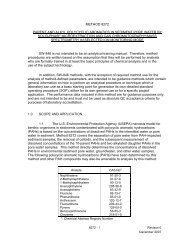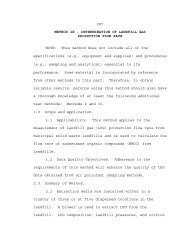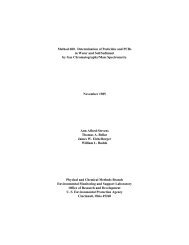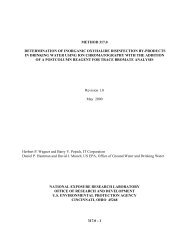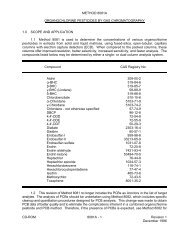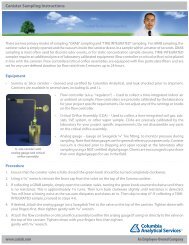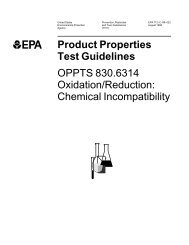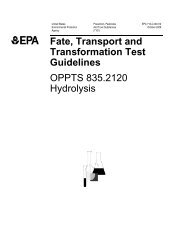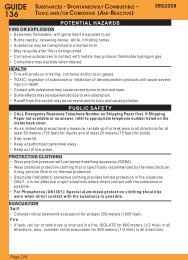Download/Print ERG Guide 125 (PDF)
Download/Print ERG Guide 125 (PDF)
Download/Print ERG Guide 125 (PDF)
Create successful ePaper yourself
Turn your PDF publications into a flip-book with our unique Google optimized e-Paper software.
Page 196GUIDE<strong>125</strong>GASES - CORROSIVEPOTENTIAL HAZARDSHEALTH• TOXIC; may be fatal if inhaled, ingested or absorbed through skin.• Vapors are extremely irritating and corrosive.• Contact with gas or liquefied gas may cause burns, severe injury and/or frostbite.• Fire will produce irritating, corrosive and/or toxic gases.• Runoff from fire control may cause pollution.<strong>ERG</strong>2008FIRE OR EXPLOSION• Some may burn but none ignite readily.• Vapors from liquefied gas are initially heavier than air and spread along ground.• Some of these materials may react violently with water.• Cylinders exposed to fire may vent and release toxic and/or corrosive gas throughpressure relief devices.• Containers may explode when heated.• Ruptured cylinders may rocket.PUBLIC SAFETY• CALL Emergency Response Telephone Number on Shipping Paper first. IfShipping Paper not available or no answer, refer to appropriate telephonenumber listed on the inside back cover.• As an immediate precautionary measure, isolate spill or leak area for at least 100 meters(330 feet) in all directions.• Keep unauthorized personnel away.• Stay upwind.• Many gases are heavier than air and will spread along ground and collect in low orconfined areas (sewers, basements, tanks).• Keep out of low areas.• Ventilate closed spaces before entering.PROTECTIVE CLOTHING• Wear positive pressure self-contained breathing apparatus (SCBA).• Wear chemical protective clothing that is specifically recommended by the manufacturer.It may provide little or no thermal protection.• Structural firefighters' protective clothing provides limited protection in fire situationsONLY; it is not effective in spill situations where direct contact with the substance ispossible.EVACUATIONSpill• See Table 1 - Initial Isolation and Protective Action Distances for highlighted materials.For non-highlighted materials, increase, in the downwind direction, as necessary, theisolation distance shown under “PUBLIC SAFETY”.Fire• If tank, rail car or tank truck is involved in a fire, ISOLATE for 1600 meters (1 mile) in alldirections; also, consider initial evacuation for 1600 meters (1 mile) in all directions.
Page 197<strong>ERG</strong>2008GASES - CORROSIVEGUIDE<strong>125</strong>EM<strong>ERG</strong>ENCY RESPONSEFIRESmall Fire• Dry chemical or CO 2.Large Fire• Water spray, fog or regular foam.• Move containers from fire area if you can do it without risk.• Do not get water inside containers.• Damaged cylinders should be handled only by specialists.Fire involving Tanks• Fight fire from maximum distance or use unmanned hose holders or monitor nozzles.• Cool containers with flooding quantities of water until well after fire is out.• Do not direct water at source of leak or safety devices; icing may occur.• Withdraw immediately in case of rising sound from venting safety devices ordiscoloration of tank. • ALWAYS stay away from tanks engulfed in fire.SPILL OR LEAK• Fully encapsulating, vapor protective clothing should be worn for spills andleaks with no fire.• Do not touch or walk through spilled material.• Stop leak if you can do it without risk.• If possible, turn leaking containers so that gas escapes rather than liquid.• Prevent entry into waterways, sewers, basements or confined areas.• Do not direct water at spill or source of leak.• Use water spray to reduce vapors or divert vapor cloud drift. Avoid allowing water runoff tocontact spilled material. • Isolate area until gas has dispersed.FIRST AID• Move victim to fresh air. • Call 911 or emergency medical service.• Give artificial respiration if victim is not breathing.• Do not use mouth-to-mouth method if victim ingested or inhaled the substance;give artificial respiration with the aid of a pocket mask equipped with a one-wayvalve or other proper respiratory medical device.• Administer oxygen if breathing is difficult.• Remove and isolate contaminated clothing and shoes.• In case of contact with liquefied gas, thaw frosted parts with lukewarm water.• In case of contact with substance, immediately flush skin or eyes with running water forat least 20 minutes.• In case of contact with Hydrogen fluoride, anhydrous (UN1052), flush skin andeyes with water for 5 minutes; then, for skin exposures rub on a calcium/jellycombination; for eyes flush with a water/calcium solution for 15 minutes.• Keep victim warm and quiet. • Keep victim under observation.• Effects of contact or inhalation may be delayed.• Ensure that medical personnel are aware of the material(s) involved and takeprecautions to protect themselves.


